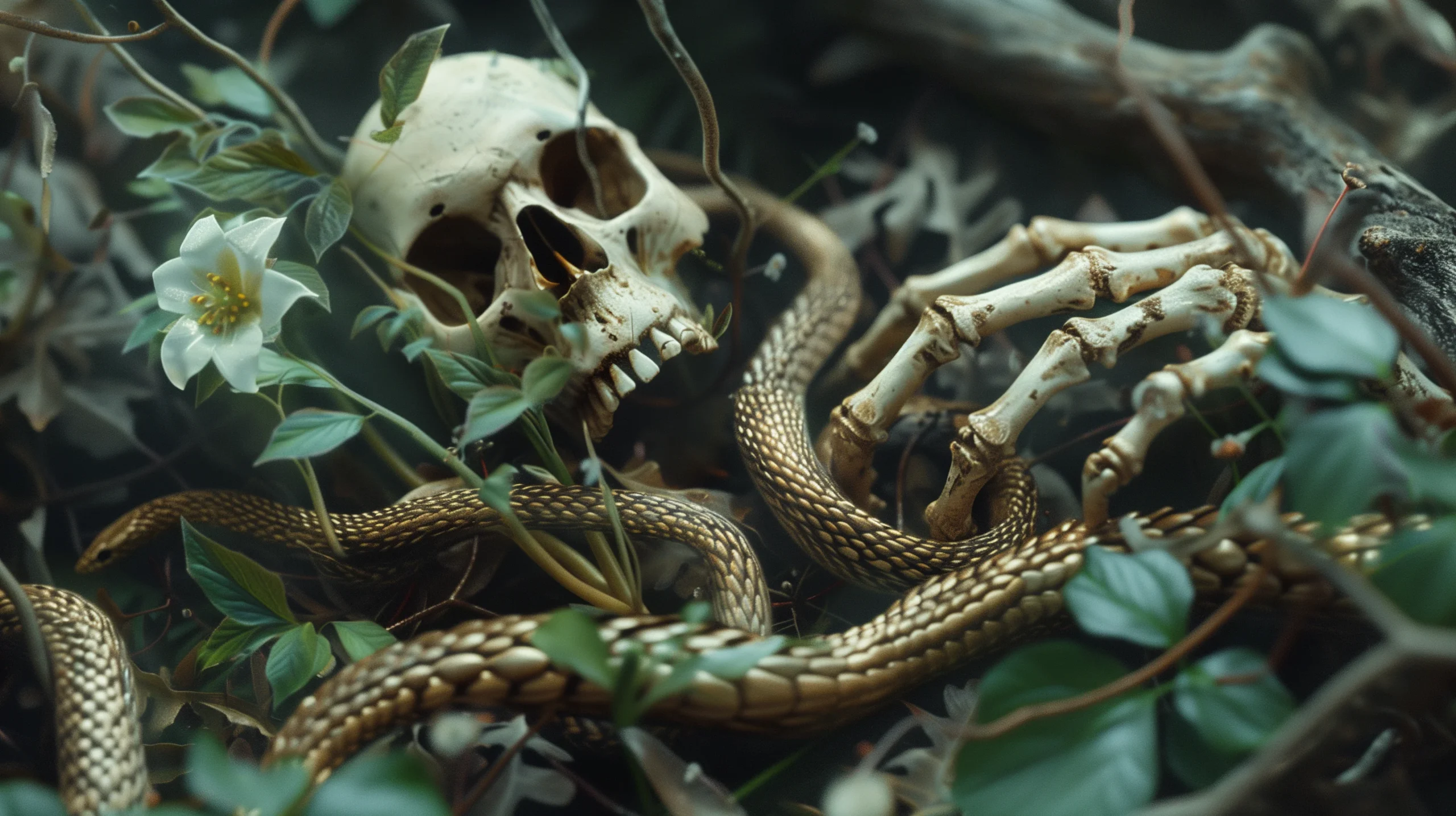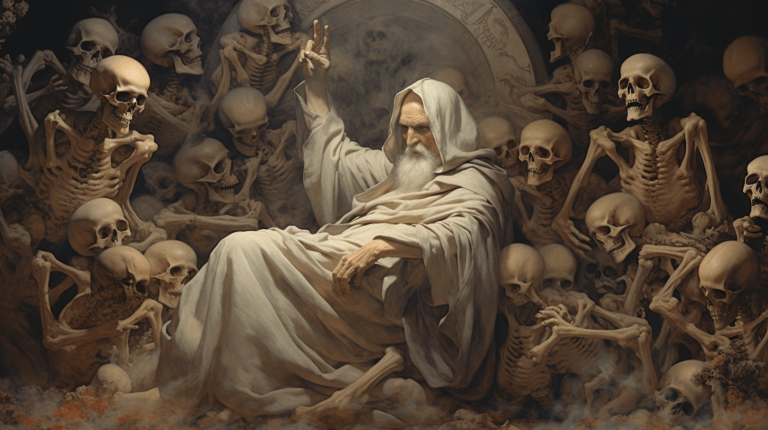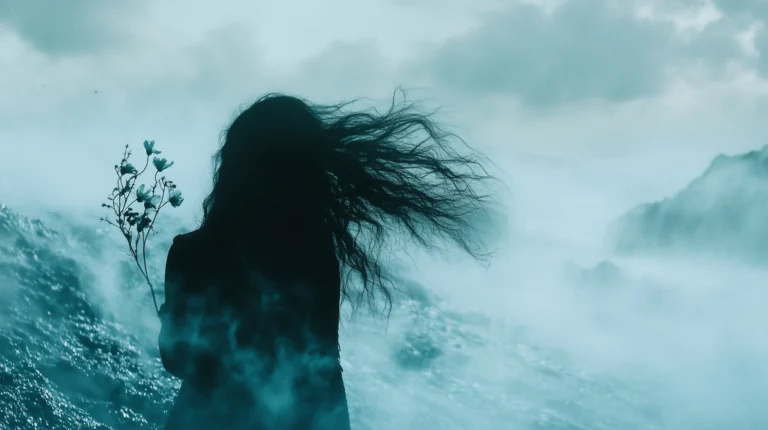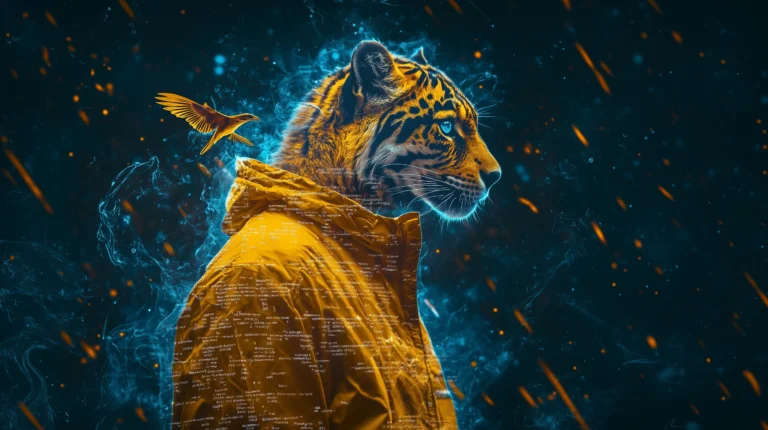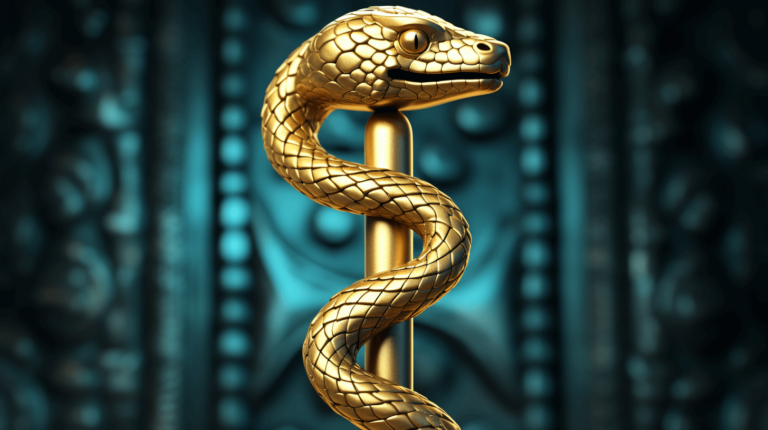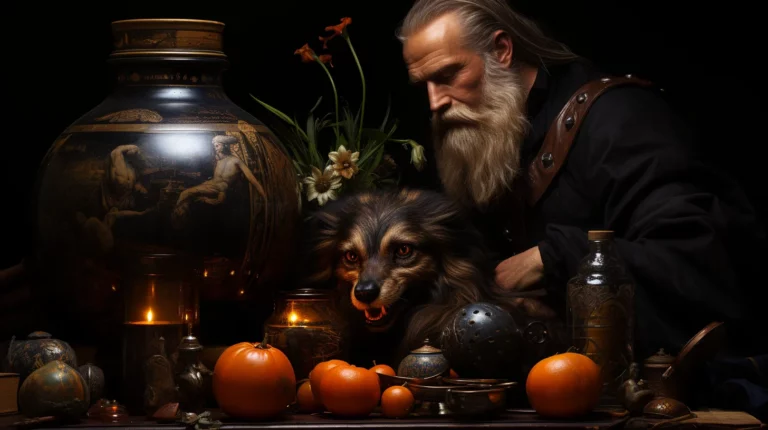Beneath the Moon’s Watchful Eye: Exploring the Symbolic Pathways to Self
Welcome to a journey through the realm of symbols, where each form holds a universe of meanings and every image is a doorway to deeper understanding. This guide is an invitation to wander through the symbolic landscapes that enrich human experience, where the mundane meets the mystical, and the simple becomes sacred.
As Virginia Woolf once remarked,
“One cannot think well, love well, sleep well, if one has not dined well.”
Similarly, one cannot live well if one does not delve into the rich symbolism that textures our lives. Here, we explore not just any symbols, but those that bridge the worlds of the visible and the invisible: the corpse skeleton hand, the withered Trillium grandiflorum, sprawling tree branches, and the enigmatic golden snake.
Each symbol is like a note in a larger symphony, played on the instruments of our collective psyche. The corpse skeleton hand, stark and somber, invites us to consider our own mortality and the legacies we wish to leave behind. It stands as a reminder of the inevitable end that binds all human endeavors. In contrast, the withered petals of the Trillium grandiflorum whisper of life’s fleeting beauty, the dignity of aging, and the natural cycles that encompass birth, growth, and decay.
Tree branches, reaching into the skies, reflect our own reaching for knowledge, growth, and connection. They remind us of the strength found in flexibility, the beauty of branching paths, and the protective embrace of old boughs that cradle life within their leaves. Meanwhile, the golden snake slithers through our consciousness, a glittering symbol of temptation and wisdom, healing and danger, asking us to explore the dualities that define our realities.
As you navigate through this guide, imagine walking through a forest thick with the myths and stories of old. Each step uncovers a layer of understanding, each turn reveals new paths in the labyrinth of the human condition. William Blake’s invitation rings true here:
“To see a World in a Grain of Sand and a Heaven in a Wild Flower, Hold Infinity in the palm of your hand And Eternity in an hour.”
In our case, it is to see a world in a skeleton hand, eternity in the lifecycle of a flower, infinity in the reach of tree branches, and a cosmos in the curve of a snake.
Ah, from the earth, skeletal hands doth reach, while the noble Trillium doth wilt, signaling rebirth anew. Meanwhile, golden snakes, in their secret dance, slither ‘mongst the bold, cold branches, whispering ancient tales. Ah, the grand ballet of nature unfolds!
Hands of bone reach through the earth,
Trillium wilts, heralding rebirth.
Golden snakes slide, secrets untold,
In the dance of the branches, bold and cold.
So let us begin, with eyes open to seeing the unseen, hearts ready to feel the unspoken, and minds prepared to embrace the complexities of symbols that surround us, guide us, and sometimes, define us. This is not just a study of symbols; it is an exploration of life itself, rendered in the language of the soul. Welcome to the symphony of symbols.
In considering the symbolic resonance of the corpse skeleton hand, we embark on a journey that crosses boundaries between the seen and the unseen, the ephemeral and the eternal. This potent symbol serves as a stark reminder of our own mortality, a visceral prompt that life, in all its vibrant complexity, is transient. The skeleton hand, stripped of flesh and muscle, lays bare the unvarnished truth of our final common denominator—death itself. As Shakespeare eloquently puts it in Hamlet,
“Imperious Caesar, dead and turned to clay, might stop a hole to keep the wind away.”
This line reminds us that no matter our earthly power or prestige, we too will return to the earth.
The skeleton hand not only confronts us with the inevitability of death but also invites us to consider what lies beyond the veil of life. It is a bridge to the archetypal Grim Reaper, a figure both feared and revered. The Reaper does not just signify the end but also the transition, a guide from the temporal world to whatever mysteries lie beyond. Here, the skeleton hand can be seen as a symbol of deep transformation, embodying the essence of what remains when all else falls away.
Psychologically, this image might stir a primal fear, a confrontation with our own subconscious dread of non-existence. Yet, it also challenges us to confront these fears, to engage with them, understand them, and perhaps learn to coexist with them. Carl Jung’s concept of the Shadow encompasses all that we are afraid to face within ourselves. The skeleton hand, as a fragment of the human form, can be perceived as a shard of our shadow, reaching out to us, urging us to integrate and accept the full spectrum of our psyche for holistic growth.
Philosophically, the skeleton hand invites a meditation on existential realism. It echoes the thoughts of existential philosophers like Kierkegaard, who mused on the individual’s navigation through the anxiety of freedom and the responsibility of existential choice.
“To dare is to lose one’s footing momentarily. Not to dare is to lose oneself.”
This symbol challenges us to dare, to embrace the fullness of life’s experiences, knowing well that they are fleeting.
Memento mori, an artistic and philosophical practice that contemplates the transient nature of life, utilizes symbols like the skeleton hand to foster mindfulness of the inevitable. It’s a call to live authentically and fully, mindful that,
“This too shall pass.”
The philosophical discourse around dualism further enriches our understanding, questioning the separation of spirit and matter, essence and existence. The skeleton hand, then, becomes a focal point for reflecting on these divisions and their implications for understanding the self and the universe.
As a symbol, the corpse skeleton hand traverses the realms of fear and fascination, death and transformation, shadow and light. It holds a mirror to our deepest existential concerns and invites a rigorous examination of what it means to be truly alive in the face of inevitable death. It’s a reminder, bleak yet profound, that in the grand dance of cosmos, from birth through life to death, we are intimately connected—not just to each other but to the very fabric of the universe.
In engaging with this symbol, we are urged to dream, to hope, and to reflect, finding within the shadow of death the sparks that illuminate life’s truest values. As we ponder on the skeletal hand, we might find that within its bony grip lies the invitation to understand life’s most profound mysteries. After all, as Rainer Maria Rilke once suggested,
“Perhaps all the dragons in our lives are princesses who are only waiting to see us act, just once, with beauty and courage.”
This, perhaps, is the ultimate challenge of the corpse skeleton hand: to act with beauty and courage, even when confronted with the inevitable demise of all things.
When we contemplate the withered petals of the Trillium grandiflorum and the sprawling limbs of tree branches, we are drawn into a quiet dialogue with the forces of life and decay, growth and stillness. The Trillium, in its prime, bursts forth with three elegant petals, each a testament to nature’s symmetry and simplicity. But as they wither, these petals transform, embodying the grace of age, each wrinkle and curve a story of the days gone by. It’s in this change that the flower whispers the old truth, famously echoed by Robert Herrick:
“This same flower that smiles today, tomorrow will be dying.”
The journey of these petals from vibrancy to a gentle fade is not just a cycle of life but a mirror reflecting our own human paths. As the petals fold inward, they might remind us of a line by Kahlil Gibran:
“Life’s most persistent and urgent question is, ‘What are you doing for others?'”
This question gains weight as we consider our own twilight years and what remains after our prime has passed. What legacy do we leave behind? How do we face the encroaching quiet?
Simultaneously, tree branches stretch upwards and outwards, their sturdiness supporting life, their sprawling nature mapping the skies. These branches, while a cradle for leaves and birds, tell their own tale of resilience and reach. They remind us of the human desire to extend ourselves beyond our immediate grasp, to explore and expand. Much like Emily Dickinson’s musing,
“Hope is the thing with feathers that perches in the soul – and sings the tunes without the words – and never stops at all,”
branches represent our own aspirations, continuously reaching for the light, persistently growing, regardless of the hardships they face.
Yet, this imagery is not just about growth and decline as separate tales. It’s about the interconnectedness of these states. The branches that reach high are fed by roots that intertwine with the earth, just as our own highs are grounded in our depths. The withering of one flower leads to the nourishment of another aspect of the garden. This cyclical process is reflective of life’s own philosophy, reminding us of the words of Heraclitus:
“No man ever steps in the same river twice, for it’s not the same river and he’s not the same man.”
These symbols — the withered petals and the resilient branches — together craft a narrative about the human condition. They teach us about the beauty inherent in the natural progression of life, about acceptance, and about the raw, relentless pursuit of existence. The decay of the petals is not a morbid finale but a poignant reminder of what growth necessitates: an end. And the branches are not just reaching for the light but also forming the very skeleton that supports the life of the tree, much like our own underlying beliefs and values support our daily pursuits.
In these natural phenomena, we find philosophical questions about our existence and reminders of our mortality. We are urged to live with intention, to nurture our roots, and to cherish the fleeting beauty of life’s moments.
As we navigate through our lives, the images of the withered Trillium grandiflorum and the enduring branches serve as symbols to guide our reflections on life, death, and the legacy we hope to leave behind. They call us to find beauty not only in the bloom but also in the withering, not only in the reaching out but also in the holding fast. They invite us to live fully, from the ground of our being to the farthest reaches of our dreams.
The golden snake coils through the sands of time and psyche, shimmering with the allure of the forbidden and the sacred. To contemplate this symbol is to dance with the dualities of our nature and the mysteries veiled within the mundane.
Consider the snake, an emblem of transformation and renewal, known universally for its ability to shed its old skin for a new one. It embodies the relentless pursuit of what is to come, and an acceptance of the necessary end of what was. When cast in gold, this transformation ascends from the mere physical to the alchemical—transmuting the base elements of existence into the gold of wisdom. Shakespeare, in his wisdom, tells us, “All that glitters is not gold,” prompting us to look deeper, beyond the surface allure to the underlying value.
In the medical world, the snake winds its way around the staff of Asclepius, becoming a symbol of healing and the restoration of health. The golden hue here does not merely elevate its status but highlights the purity and ultimate value of health and life itself. It’s a stark reminder that the most profound healing often comes from confronting the venomous aspects of life or ourselves, turning poisons into remedies.
Yet, this symbol also carries the weight of temptation and danger. The very allure that draws us to the golden snake is what makes it dangerous. This serpent does not just offer forbidden fruit but promises greater, often hidden, knowledge and power. As we reach for what it offers, we must beware, for as Einstein said,
“A little knowledge is a dangerous thing. So is a lot.”
On a philosophical plane, the golden snake slithers between the material and the spiritual, provoking a meditation on what constitutes real treasure. Is it the glittering gold, or is it the wisdom and insight that come from the experiences of embracing and understanding the most profound fears and desires represented by the serpent?
This creature embodies moral dualism—representing healing and poison, creation and destruction, life and death—all encapsulated in the singular figure of a snake made of the most covetable metal. It challenges us to find the wisdom in deception, the life in death, and the creation in destruction. It asks us to ponder the complexities of moral choices and the intertwined nature of good and evil.
For those drawn to the mythological, the image of the snake biting its tail, the Ouroboros, speaks of eternal return and the cyclical nature of the universe. Here, rendered in gold, the Ouroboros not only underscores the perfection and completeness of these cycles but also enriches them with divine significance, illustrating the holistic and infinite nature of the universe’s wisdom. As Jung said,
“The meeting of two personalities is like the contact of two chemical substances: if there is any reaction, both are transformed.”
Thus, the golden snake is not just a symbol but a journey. It invites us on a path that spirals into the depths of our own desires, confronts us with our fears, and elevates us towards a higher understanding. It offers a lens through which we might view the world, not as a series of disjointed happenings but as a continuous flow of life, death, and rebirth—each phase as necessary and as beautiful as the other.
In engaging with this symbol, we weave our own lives into the perpetual narrative of renewal, each shedding of our skin a rebirth into a wiser self, each embrace of the golden wisdom a step towards enlightenment. Through the golden snake, we are reminded to cherish the journey as much as the destination, for in each ending there is a new beginning, and in every coil of its body, a universe of meaning waiting to be discovered.
As we draw the curtains on our exploration of symbols, we are left with a rich palette of images that speak of life, death, transformation, and wisdom. The journey through the symbolism of the corpse skeleton hand, the withered Trillium grandiflorum, sprawling tree branches, and the enigmatic golden snake has not merely been an academic exercise; rather, it has been a deep dive into the well of personal development and spiritual growth.
As we intertwine these rich strands, we craft a reflection of Hathor, the ancient Egyptian goddess who radiates joy, embodies motherhood, and presides over the profound cycles of life and death. Hathor, like the symbols we explore, traverses both the realms of the living and the departed, providing protection and guidance, nurturing with a maternal touch, and weaving the universe’s oldest narratives with the melodies of her sistrum.
Yet, in this exploration, we’re not tethering these symbols to Hathor through a strictly traditional or mythologically rigid lens. Instead, we embrace a more personal path—creating a reality uniquely ours, a perfect equilibrium that resonates with our individual spirits. The idea here transcends conventional interpretations; these symbols, deities, and archetypes offer us not just knowledge but a canvas. On this canvas, angels, demons, gods, and signs become guides on a journey that’s inherently personal, etched deeply within us.
These mystical figures and icons are more than just external entities; they are integral parts of our inner landscapes, waiting to be navigated and understood. Each one presents a road, a unique route through which we can navigate the adventure of life, forging meanings that are profoundly personal and distinctly our own. Here’s to celebrating that journey, to embracing the myriad roads we might travel, and to finding joy in the creation of a reality that truly makes sense to us. Let the dance with our inner pantheon begin!
The corpse skeleton hand, stark and unyielding, reminds us of Hathor’s role as a guardian in the journey after death, guiding souls through transitions. Just as this symbol encourages us to face our mortality with courage, Hathor’s compassion soothes our fears about the unknown, nurturing our acceptance of the life cycle’s natural progression.
Meanwhile, the withered petals of the Trillium grandiflorum echo Hathor’s connection to fertility and beauty, which flourishes and fades in a perpetual dance of seasons. These cycles are not just markers of time but are essential for personal growth and renewal—reminding us that each ending paves the way for a new beginning. As Hathor embodies the fullness of life, so does each petal remind us to embrace all phases of our existence, from the bloom of youth to the grace of age.
The outstretched tree branches, resilient and reaching, mirror Hathor’s nurturing arms. They invite us to grow, to reach for the light of understanding and wisdom, and to connect deeply with the world around us. The branches teach us about the strength found in vulnerability—how to bend without breaking under the weight of our experiences.
The golden snake, with its dual promise of danger and wisdom, compels us to integrate our shadow selves, much like Hathor, who unites with her alter ego, Sekhmet, in a balance of creation and destruction. This symbol challenges us to explore deeper truths within us, to confront and reconcile the contrasting aspects of our nature in the pursuit of spiritual and psychological wholeness.
By reflecting on these symbols through the lens of Hathor’s mythology, we find not only ancient wisdom but also practical insights for contemporary life. “Knowing yourself is the beginning of all wisdom,” Aristotle once stated, and through this journey of symbols, Hathor encourages just that—a profound introspection and harmonization of our inner landscapes.
Let us take these symbols as keys to unlock the deeper chambers of our hearts and minds, where all growth begins. This exploration has been a reminder of the interconnectedness of all things and the beautiful complexity of the human spirit. Just as Hathor crosses realms, may we too find the courage to traverse our inner worlds, discovering uncharted territories of self and spirit.
As we conclude, let’s remember that wherever we find ourselves currently is precisely where we need to be. It’s a thought echoed in the tranquil assurance that comes with understanding Hathor’s archetypal role—not just as a deity of the ancient world but as a symbol of maternal protection and guidance through the cycles of life and death, growth and renewal.
This journey of self and symbolism, much like the meandering paths of the withered Trillium grandiflorum or the vast reaches of tree branches, has been about finding stability and peace in the throes of life’s inevitable transformations. It serves as a reminder, much like Marcel Proust’s words,
“The real voyage of discovery consists not in seeking new landscapes, but in having new eyes.”
Through these symbols, we gain new eyes to see ourselves and our places in the world with clarity and compassion.
Trust in your journey and in the timing of your life. Trust in yourself, even when the road turns shadowy and uncertain, much like the deceptive allure of the golden snake or the stark reminder of mortality in the skeletal hand. Stay clear of guilt, fear, and negativity—those shadows that cloud vision and hinder growth. Embrace instead the light of understanding and the warmth of self-compassion, recognizing, as Hathor would, the sacredness in all phases of life’s journey.
Our deities may vary, our myths might differ, but the essence of our human experience—the struggle, the misery, the quest for meaning—remains universally shared. The philosopher Søren Kierkegaard once remarked,
“Life can only be understood backwards; but it must be lived forwards.”
As we navigate our paths, it is crucial to offer ourselves the same compassion we strive to extend to others. Be gentle with yourself; celebrate your presence exactly where you are, and know that you are secure in this moment’s embrace.
Let the universe unfold its plan. Engage with life not as a passive observer but as an active co-creator in the divine scheme. The symbols we’ve explored invite you to flow with life’s tides and to participate with intention and openness in the world around you. Ralph Waldo Emerson wisely stated,
“The only person you are destined to become is the person you decide to be.”
This guidance encapsulates our call to action: to flow with grace, to harness the wisdom of symbols like the golden snake and the nurturing branches, and to embody the transformative energy they represent.
In the spirit of Hathor, embrace your role in the cosmic dance—honor your past, engage with your present, and move towards your future with a heart full of hope and hands ready to shape and be shaped by the divine plan. As you continue your journey, remember that each symbol, each story, is a guidepost along the way, illuminating paths to wisdom and fulfillment. Live deeply, love boldly, and let your life be a testament to the beauty and complexity of being truly human.
“From my rotting body, flowers shall grow and I am in them, and that is eternity.”
Edvard Munch
In the garden of the night where whispers dwell,
Beneath the moon’s watchful eye, secrets swell.
A skeleton’s hand stretches from the earth,
Grasping at the silence, a dark rebirth.
Along comes the trillium, with petals three,
Wearing drops of dew like jewels, carefree.
Its beauty whispers of a transient dance,
In the winds of time, a fleeting, tender glance.
Branches sprawl like thoughts into the sky,
Crackling tales of old, where crows oft fly.
Each leaf a story, each knot a dream,
In the forest’s heart, where shadows teem.
A golden snake slithers with a grin,
Its scales aglow, secrets held within.
Temptation’s ribbon in the grass,
A gleaming thread of tales, alas.
Enter Hathor, with her sistrum’s song,
Amidst life’s fields, where she belongs.
She dances through the cycle, fierce and kind,
In each symbol, a truth to find.
“Embrace your shadows, your light, your song,”
She hums to all who follow along.
With every step, the earth sings anew,
Of death, of life, and the morning dew.
In this symphony of symbols, find your part,
Play it with courage, wisdom, and heart.
For in the game of life, as in art,
The end is just another start.
So let us dance with skeleton, leaf, and snake,
Finding joy in the paths we dare to take.
For in each ending, and each small death,
Lies the sweet promise of another breath.
Hathor’s laughter fills the air,
A reminder to live fully, without despair.
To hold infinity in the palm of your hand,
And eternity in an hour’s sand.
Breathe in the world, brave and free,
For you are exactly where you ought to be.
In the garden of the night, let your spirit soar,
With each symbol a key to an unopened door.
Ah, from the earth, skeletal hands doth reach, while the noble Trillium doth wilt, signaling rebirth anew. Meanwhile, golden snakes, in their secret dance, slither ‘mongst the bold, cold branches, whispering ancient tales. Ah, the grand ballet of nature unfolds!
Hands of bone reach through the earth,
Trillium wilts, heralding rebirth.
Golden snakes slide, secrets untold,
In the dance of the branches, bold and cold.

